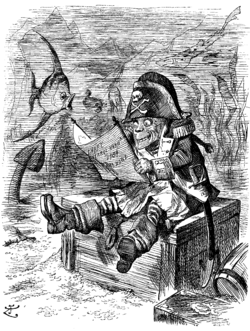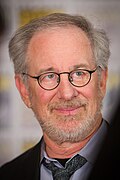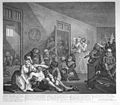Portal:Cartoon
The Cartoon Portal

A cartoon is a type of visual art that is typically drawn, frequently animated, in an unrealistic or semi-realistic style. The specific meaning has evolved, but the modern usage usually refers to either: an image or series of images intended for satire, caricature, or humor; or a motion picture that relies on a sequence of illustrations for its animation. Someone who creates cartoons in the first sense is called a cartoonist, and in the second sense they are usually called an animator.
The concept originated in the Middle Ages, and first described a preparatory drawing for a piece of art, such as a painting, fresco, tapestry, or stained glass window. In the 19th century, beginning in Punch magazine in 1843, cartoon came to refer – ironically at first – to humorous artworks in magazines and newspapers. Then it also was used for political cartoons and comic strips. When the medium developed, in the early 20th century, it began to refer to animated films that resembled print cartoons. (Full article...)

In print media, a cartoon is a drawing or series of drawings, usually humorous in intent. This usage dates from 1843, when Punch magazine applied the term to satirical drawings in its pages,[1] particularly sketches by John Leech.[2] The first of these parodied the preparatory cartoons for grand historical frescoes in the then-new Palace of Westminster in London.[3]

Sir John Tenniel—illustrator of Alice's Adventures in Wonderland—joined Punch in 1850, and over 50 years contributed over two thousand cartoons.[4]
Selected article -
Steven Spielberg Presents Animaniacs is an American animated television series, distributed by Warner Bros. and produced by Amblin Entertainment. The cartoon was the second animated series produced by the collaboration of Steven Spielberg (pictured) and Warner Bros. Animation during the animation renaissance of the late 1980s and early 1990s. The studio's first series, Tiny Toon Adventures, was a success among younger viewers, and a series that attracted a sizable number of adult viewers. The Animaniacs writers and animators, led by senior producer Tom Ruegger, used the experience gained from the previous series to create new animated characters that were cast in the mold of Chuck Jones and Tex Avery's creations. Animaniacs first aired on "FOX Kids" from 1993 until 1995 and later appeared on The WB from 1995 to 1998 as part of its "Kids' WB" afternoon programming block. The series had a total of 99 episodes and one film, titled Wakko's Wish. Like other animated series, it continued to appear on television through syndication long after its original airdate.
Selected character -
Mickey Mouse is a cartoon character who has become an icon for The Walt Disney Company. Mickey Mouse was created in 1928 by Walt Disney and Ub Iwerks and voiced by Walt Disney. The Walt Disney Company celebrates his birth as November 18, 1928, upon the release of Steamboat Willie, (Steamboat Willie being the first Mickey Mouse Cartoon with sound). The anthropomorphic mouse has evolved from being simply a character in animated cartoons and comic strips to become one of the most recognizable symbols in the world. Mickey is currently the main character in the Disney Channel's Disney Junior series "Mickey Mouse Clubhouse". Mickey is the leader of The Mickey Mouse Club. In late 2009, The Walt Disney Company announced that they will begin to re-brand the Mickey Mouse character by putting a little less emphasis on his pleasant, cheerful side and reintroducing the more mischievous and adventurous sides of his personality, starting with the newly released Epic Mickey.
Did you know... -
- ...that the film Green Lantern starring Ryan Reynolds has been in development since the 1990s and once included a comedic incarnation with Jack Black set to star?
- ...that the Fire Nation, from the Universe of Avatar: The Last Airbender, was inspired by photos of volcanic islands of Iceland and the Pacific Ocean?
- ...that Uri-On, created by Michael Netzer in 1987, was the first Israeli superhero to be published in color?
- ...that pixel artists are featured in an annual juried art show, "Into the Pixel", at the E3 trade show for computer and video game industries?
Selected list -
The Hugo Award for Best Graphic Story is given each year for science fiction or fantasy stories told in graphic form and published in English or translated into English during the previous calendar year. The Hugo Award for Best Graphic Story has been awarded annually since 2009. It was started then with the requirement that it would only continue as an official award if approved again by the World Science Fiction Society after that year. It was, and was again awarded in 2010; it will need to be ratified again after the 2012 awards in order to continue. Hugo Award nominees and winners are chosen by supporting or attending members of the annual World Science Fiction Convention, or Worldcon, and the presentation evening constitutes its central event. The selection process is defined in the World Science Fiction Society Constitution as instant-runoff voting with five nominees, except in the case of a tie as happened in 2009. In the four years that the award has been active, twenty-one works from twelve series have been nominated. Girl Genius, written by Kaja and Phil Foglio, drawn by Phil Foglio, and colored by Cheyenne Wright, won the first three awards.
General images -
Selected biography -
William Hanna (1910–2001) was an American animator, director, producer, and cartoonist, whose movie and television cartoon characters entertained millions worldwide for much of the twentieth century. Hanna joined the Harman and Ising animation studio in 1930 and steadily gained skill and prominence while working on cartoons such as Captain and the Kids. In 1937, while working at Metro-Goldwyn-Mayer (MGM), Hanna met Joseph Barbera. The two men began a collaboration that was at first best known for producing Tom and Jerry and live action films. In 1957, they co-founded Hanna-Barbera, which became the most successful television animation studio in the business, producing programs such as The Flintstones, The Huckleberry Hound Show, The Jetsons, Scooby-Doo, The Smurfs, and Yogi Bear. In 1967, Hanna-Barbera was sold to Taft Broadcasting for $12 million, but Hanna and Barbera remained heads of the company until 1991. At that time the studio was sold to Turner Broadcasting System, which in turn was merged with Time Warner, owners of Warner Bros., in 1996; Hanna and Barbera stayed on as advisors. Hanna and Barbera won seven Academy Awards and eight Emmy Awards. Their cartoons have become cultural icons, and Hanna-Barbera's shows have a global audience of over 300 million people.
Subcategories
WikiProjects
- Main projects
- Arts • Animation • Comics • Entertainment • Visual arts
- Related Projects
- Anime and manga • Biography • Film • Fictional characters • Media franchises • Music • Television • Video games
Selected quote -
Topics
- Comic book
- Comic strip
- Digital comics
- Graphic novel
- Mobile comic
- Motion comics
- Trade paperback
- Webcomic
- Animator
- Animation director
- Animation studios
- Animation film festivals
- Feature-length films
- Short films
- Television series
- Computer-animated films
- Stop-motion films
- Traditional animation
- Limited animation
- Rotoscoping
- Stop Motion
- Clay
- Cutout
- Graphic
- Model
- Object
- Pixilation
- Puppetoon
- Computer animation
- Flash animation
- PowerPoint animation
- SVG animation
- Cel-shaded animation
- Crowd simulation
- Morph target animation
- Motion capture
- Non-photorealistic rendering
- Skeletal animation
Things you can do

- Requested articles: Fenwick (comics), Khimaera (comics), Mutant Underground Support Engine, Bruce J. Hawker, Marc Dacier, Hultrasson, Frankenstein Comics, Dave Johnson (comics), Paco Medina, Dappere Dodo, New Adventures of the Space Explorers, Habatales, Musical Box, Foo-Foo (TV series), Bonne nuit les petits, The Adventures of Lariat Sam, More...
- Images and photos needed: Request images that are needed from Wikipedia requested images of comics and animation to included in each articles.
- Stubs: Work on stubs in articles in Comics and Animation stubs.
- Infobox: Add infobox that are needed from Category:Comics articles without infoboxes and Category:Animation articles needing infoboxes in articles.
- Deletion sorting: Please see the collection of discussions on the deletion of articles related to comics and animation - compiled by WikiProject Deletion sorting
Related portals
Associated Wikimedia
The following Wikimedia Foundation sister projects provide more on this subject:
-
Commons
Free media repository -
Wikibooks
Free textbooks and manuals -
Wikidata
Free knowledge base -
Wikinews
Free-content news -
Wikiquote
Collection of quotations -
Wikisource
Free-content library -
Wikiversity
Free learning tools -
Wiktionary
Dictionary and thesaurus
More portals
Sources
- ^ Punch.co.uk. "History of the Cartoon". Archived from the original on 2007-11-11. Retrieved 2007-11-01.
- ^ Adler & Hill 2008, p. 30.
- ^ "Substance and Shadow: Original Editorial Accompanying "Cartoon, No. I"". Victorian web.org. Retrieved 29 October 2023.
- ^ "Sir John Tenniel". National Portrait Gallery. Retrieved 26 August 2022.





























